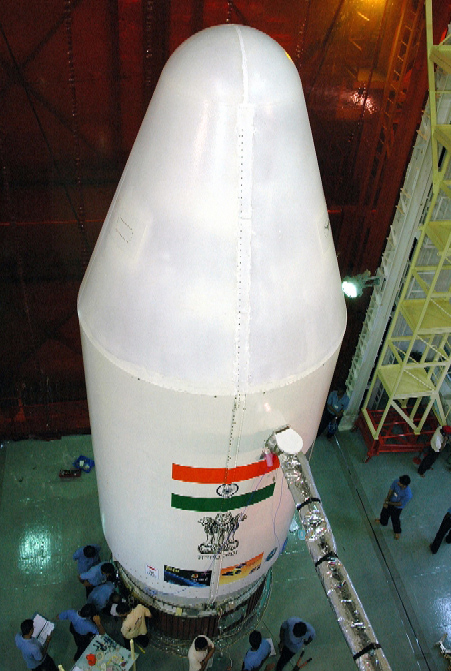Let India Launch Your Spacecraft
Last week’s launch of an Israeli observation satellite, and an Italian one last April, has put the Indian Space Research Organization’s (ISRO) capabilities on display for the world to see. Developing a commercial launch operation is a huge undertaking and now Antrix, the commercial/marketing arm of the ISRO, is ready to compete in the launch business:
Antrix hopes to bag around three commercial launch contracts for PSLV in 2009.
To be a major player in the launch market, Antrix is also planning a slew of measures. These include a three-stage PSLV to ferry 500 kg satellites for low earth orbit, a new 229-tonne ‘core alone’ configuration that can carry 1,100 kg satellites into SSO, and a vehicle to carry 1,900 kg satellites in SSO by increasing the fuel in stage two and improving the thrust power.
‘We can also look at the potential of our other rocket, Geosynchronous Launch Vehicle (GSLV), only in its Mark III version,’ Murthi said.

According to Frontline, the folks at Antrix are very proud of their accomplishment and happy to share some details surrounding the TecSAR mission (and some pricing info):
At the press conference itself, the emphasis was on how it was “a red-letter day” and “a landmark” event for Antrix because the successful orbiting of Tecsar signified the second full-fledged commercial launch by Antrix. The first one was on April 23, 2007, when a core-alone configuration of PSLV, without its customary six strap-on motors that surround the first stage, put an Italian astronomy satellite called Agile into orbit. Madhavan Nair said, “We won the contract [for launching Tecsar] against stiff competition from many other players. The orbit we achieved will be the envy of any person in the launch service. It recognises the launch capability of ISRO on par with other leading players in the world.”
K.R. Sridhara Murthi, Managing Director, Antrix, said that for putting Tecsar into its difficult orbit, they had “charged quite a lot above” the international rate of $15,000 to $20,000 a kg. During launches in January, April and September 2007, from Sriharikota, and also during the International Astronautical Congress in Hyderabad in September 2007, ISRO top brass had dodged questions on whether ISRO was planning to launch any Israeli satellite. As per the original plan, the core-alone PSLV that was to launch Tecsar in September 2007 had been assembled, and the satellite had reached SHAR from Israel and undergone tests. But the launch was postponed. So ISRO dismantled the vehicle and the Israelis bottled up the satellite.
In the first week of December 2007, newspapers and television channels went to town saying that ISRO had “abandoned” the launch of Tecsar under pressure from the United States, which did not want ISRO to get a slice of the launch market. Informed ISRO officials, however, said there was pressure from the Gulf countries on India to call off the launch of the Israeli satellite, and so the Ministry of External Affairs wanted ISRO to bide its time.
Madhavan Nair denied any such pressure from the Gulf countries. The lift-off was to take place in September 2007, but certain “technical issues” [with the satellite] forced the postponement of the launch, then the monsoon intervened. The launch took place in January after the monsoon, he said. According to the ISRO Chairman, Israel did not want any publicity until the launch was successful.